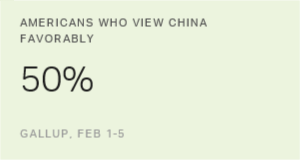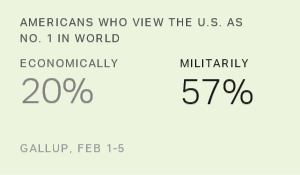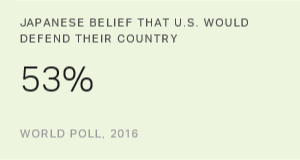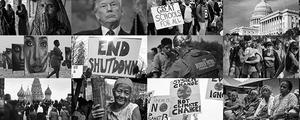Story Highlights
- 50% in U.S. now view China favorably
- Current rating is China's best since February 1989
- Democrats view China far more favorably than Republicans do
WASHINGTON, D.C. -- Americans have been feeling more positively toward China in recent years, and now 50% say they have a favorable opinion of that country -- up from 44% in 2016 and 41% in 2012. This is the highest for this measure in Gallup trends since a 72% reading in February 1989, months before the Chinese government's violent crackdown on pro-democracy protesters at Tiananmen Square sent its U.S. favorable rating tumbling to 34%.

After remaining low for about a decade following the Tiananmen Square incident, Americans' favorable rating of China rose to the low 40s in 2001 -- the same year China joined the World Trade Organization -- and remained in the 40s until now.
China's favorable rating was only 38% in 1985 but registered 72% in Gallup's next reading, in February 1989, taken days after President George H.W. Bush returned from a diplomatic visit to China.
Democrats and Independents Explain China's Image Upgrade
Since settling into favorable ratings near 40% in 2001, China's image has generally improved among Democrats and -- to a lesser extent -- political independents, while it has sagged among Republicans. Partisan divergence has been especially wide since 2011, when Democrats' favorability toward China first crossed the 50% mark; during the same period, Republicans' has been no higher than 40%.
Although President Donald Trump is known for his tough stance toward China on trade, Republican skepticism about China clearly predates Trump's rise in the Republican Party after he announced his candidacy for president in 2015.
Today, 58% of Democrats and 53% of independents view China favorably, well exceeding the 38% of Republicans with this perspective. However, the six-percentage-point rise in China's overall favorability in the past year, from 44% to 50%, is explained by increases among both Democrats and Republicans.
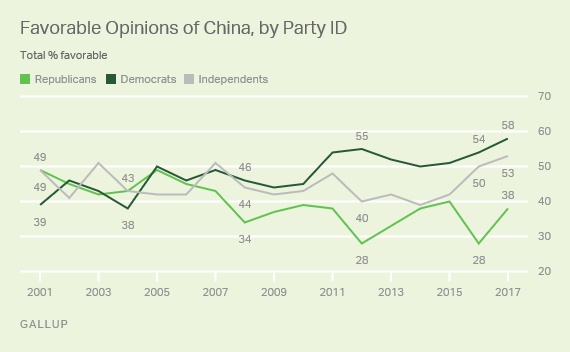
Bottom Line
In the three decades that followed the Tiananmen Square massacre, more Americans viewed China unfavorably than favorably. But the balance has shifted, and now 50% view the world's most populous nation favorably and 48% unfavorably. Although Republicans still hold a more negative than positive view of China, the 38% currently viewing that nation favorably is up from 28% in 2016; and now, a majority of independents -- along with a majority of Democrats -- share that view.
U.S.-China relations have never been entirely smooth. Tensions over Taiwan, nuclear arms and human rights are always close to the surface, and various military as well as espionage incidents have complicated matters further over the years. Trump's election as U.S. president adds more complexity to these relations. Shortly after winning the 2016 election, he flouted convention by speaking directly to Taiwan's leader, but then recently affirmed the United States' commitment to a One-China policy that means not recognizing Taiwan. What all this, as well as Trump's intentions on trade, portends for the future of U.S.-China relations is unclear. However, it may be helpful for the new administration to know that Americans are feeling relatively positively toward China right now, and thus may be less receptive to a hard-nosed approach to U.S.-China relations.
Historical data are available in Gallup Analytics.
Survey Methods
Results for this Gallup poll are based on telephone interviews conducted Feb. 1-5, 2017, with a random sample of 1,035 adults, aged 18 and older, living in all 50 U.S. states and the District of Columbia. For results based on the total sample of national adults, the margin of sampling error is ±4 percentage points at the 95% confidence level. All reported margins of sampling error include computed design effects for weighting.
Each sample of national adults includes a minimum quota of 70% cellphone respondents and 30% landline respondents, with additional minimum quotas by time zone within region. Landline and cellular telephone numbers are selected using random-digit-dial methods.
View survey methodology, complete question responses and trends.
Learn more about how the Gallup Poll Social Series works.
